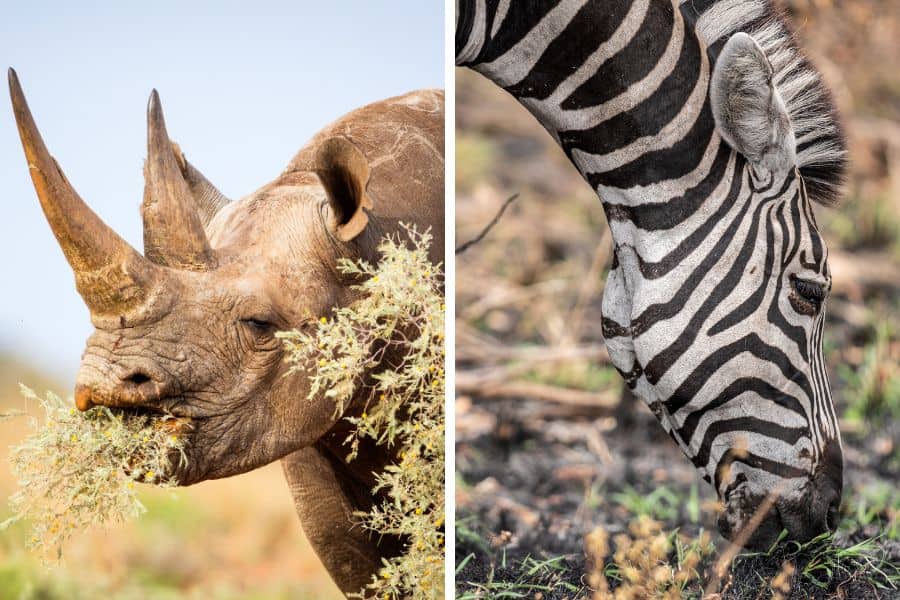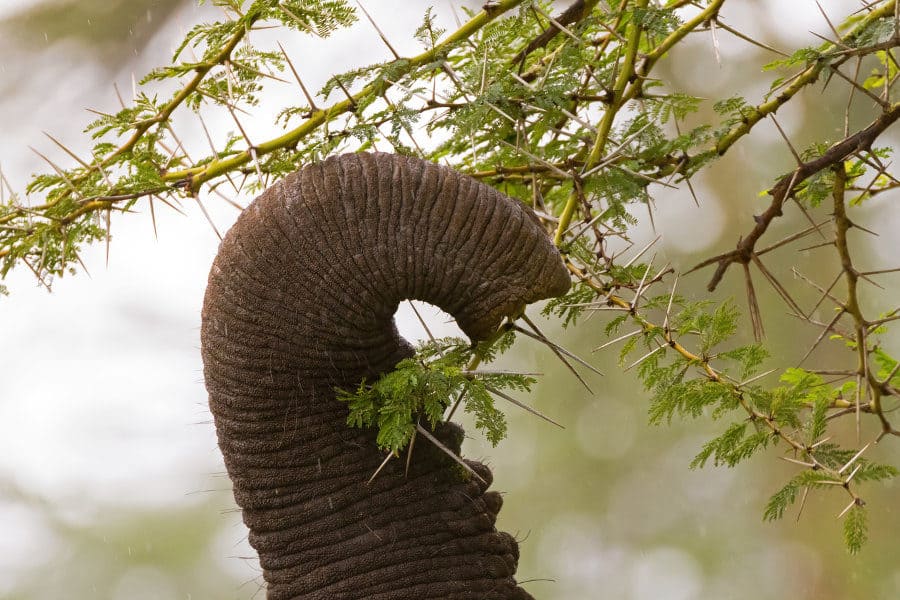Browsing vs grazing. The terms might not sound connected, but they describe the main herbivore feeding methods.
Africa abounds with plant-eating animals, all adapted to their environment in their own way. Yet, this diverse group can generally be split into two camps – browsing vs grazing animals.
You might look at a giraffe and a zebra and call them both herbivores. While that’s true, it doesn’t tell the whole story. These species eat different things, and they use different methods to get a meal.
Focusing on different foods is key for the health of an ecosystem, as it allows many herbivores to live in the same place without competing for resources.
So, what’s the difference between browsers and grazers? Find out all about these feeding strategies, and which animals employ them.
What is Browsing?
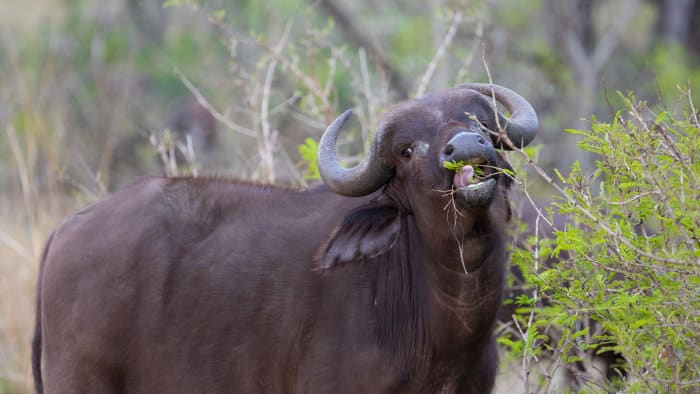
If a herbivore is “just browsing”, it’s not looking around the vegetation with no intent to eat. Window shopping isn’t an effective survival strategy.
What is browsing, then?
In the animal kingdom, a “browser” is a herbivore that feeds on leaves, shoots, tree bark, or fruits from high-growing plants. Browsing animals take this material, known as browse, directly from the plant.
Browsers come in many different shapes and sizes and can co-exist even if they feed on the same trees. Taller animals can access the treetops, while smaller species feed on the branches below.
What is Grazing?
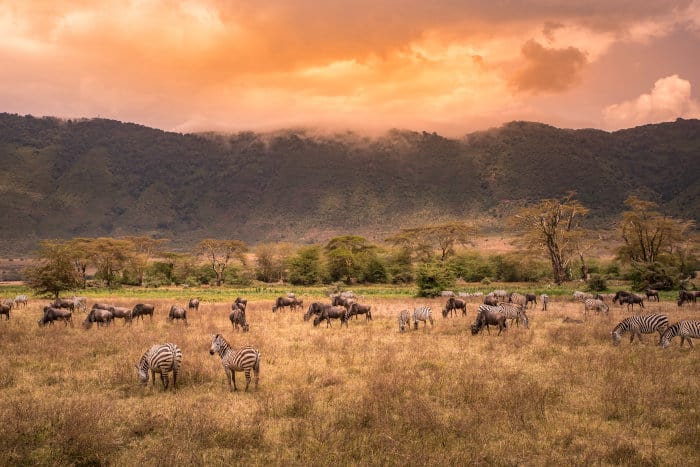
Unlike browsing animals, grazers focus on plants closer to the ground.
Grazers feed on grass and other low-growing vegetation. They’ll move around based on the quality of grazing, and several species migrate great distances to where the grass is (literally) greener.
When there’s abundant rainfall, the African plains and savannahs can support huge herds of grazers. In times of drought, numbers decline, and the animals congregate around the few remaining water sources.
Like browsers, different grazers eat different kinds of, or parts of the grass, allowing many species to live alongside one another.
Browsing vs Grazing Examples
Where do some of Africa’s most famous animals fit on the “browsing vs grazing” scale?
An obvious example of a browsing animal is the giraffe. The world’s tallest animal is ideally suited to accessing food other species simply can’t reach.
With their long neck and long legs, giraffes can browse the treetops for their favourite food – which is acacia twigs and leaves.
Their height can be a double-edged sword, making it hard to bend down and eat vegetation closer to the ground, or drink water.
Other browsing animals in Africa
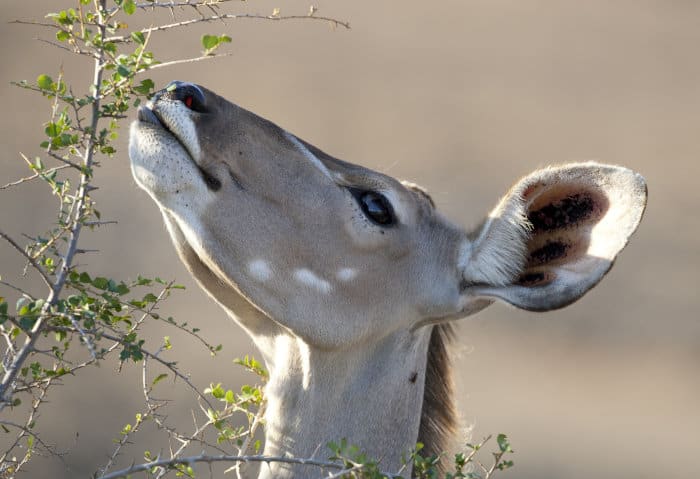
Giraffes are the most conspicuous, but far from the only browsing animals in Africa. Several antelope species, including kudu, are also browsers.
Another unexpected browser is the black rhino. At first glance, it might seem similar to large grazers like hippos or bovines. Yet this species prefers leafy plants, shoots, and woody bushes.
Black rhinos are more selective about their diet than many herbivores, favouring scrub, woodland, and bushland where they can select high-quality vegetation.
African grazers
Many of Africa’s grazers are hard to miss. They form vast herds, often including different species.
Focusing on food can be risky when other animals want to make a meal of them. In a herd, there’s safety in numbers, and feeding together means more opportunities to spot predators.
Two examples of grazing animals are zebra and wildebeest. These species make up most of the animals involved in the great migration, one of nature’s biggest spectacles.
Every year, over two million wildebeest, zebra, and gazelle travel across the Serengeti, in East Africa, to reach Kenya’s Masai Mara.
They’re not just travelling for the sake of it. These herbivores “follow the rain”, searching for greener pastures and grazing on grass as they go.
Hungry, hungry hippos

The hippopotamus is another grazing animal with a slightly different lifestyle. These rotund river-dwellers may spend much of their time in the water, but don’t usually feed there.
Despite their huge canine teeth, hippos mainly eat grass.
The semi-aquatic mammals spend much of their day staying cool in the water. When the sun starts to go down, hippos wander onto land and spend much of the night grazing.
Differences Between Browsers and Grazers
There are many differences between browsers and grazers, from external and internal adaptations, to habitats and feeding methods.
Yet there are also several similarities.
Different foods = different habitat
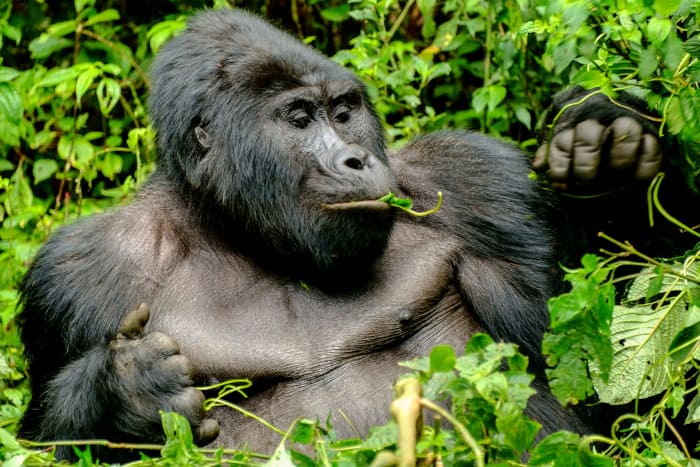
Since they favour different foods, it makes sense that browsers and grazers prefer different habitats.
Grass-eaters, (un)surprisingly, live on the grasslands. Browsers, on the other hand, require a variety of trees and bushes.
Despite their differing diets, browsing and grazing animals can often co-exist. That’s because certain habitats, like the savannah, have a mixture of grass and open woodland.
A giraffe can walk from one tree to another, past a herd of Cape buffalo grazing on grass below.
Some species are more specialised. Many browsers, like kudu, prefer more densely vegetated areas in which to feed and shelter.
Grazers aren’t just confined to open grasslands. Forest-dwellers like mountain gorillas, for instance, graze on bamboo.
NB: Since bamboo is officially a type of grass, mountain gorillas can be at least partially described as grazers. Yet due to their varied plant-based diet, they’re certainly browsers too (and the other gorilla species even more so).
Browsing vs grazing adaptations
Digesting tough plant material requires a strong stomach.
Ruminants, which can be grazers, like buffalo, or browsers, like giraffe, have four-chambered stomachs.
They’ll swallow partially chewed food, which is broken down by microorganisms in the rumen – one part of their stomach.
They’ll also regurgitate partially digested food and re-chew it, known as “chewing the cud”. This makes it easier to digest.
Other herbivores, like elephants, zebras, or rhinos, are hindgut fermenters, with a single-chambered stomach.
They eat large amounts of low-nutrient vegetation, but their digestive system processes food more rapidly than ruminants’ four-chambered stomachs.
One difference regarding browsing vs grazing is water consumption. Grazers need to drink a lot more water, while browsers get a lot of hydration from their diet.
Wide mouths and long tongues
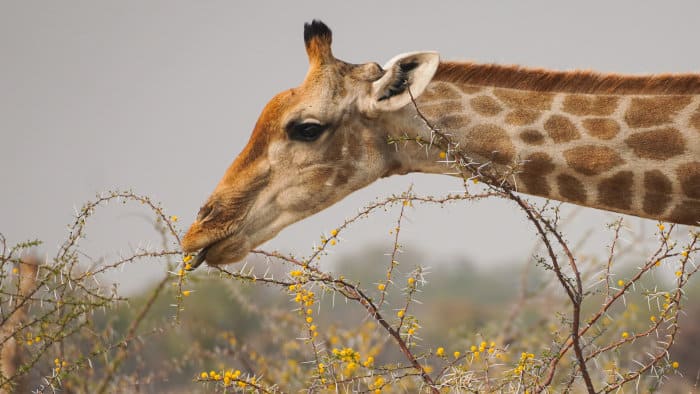
Grazing animals generally have a simple approach to feeding – bend down and munch on grass! Grazers often have broad muzzles to grab big mouthfuls.
Browsers are a bit more selective. They tend to have narrower mouths to pick out the choicest pieces of foliage. Some, like giraffes and okapis, have long, rough tongues to strip foliage off thorny branches.
Black vs white rhino
Even closely related animals have evolved separate adaptations for feeding. One of the best examples involves black rhinos and white rhinos.
As mentioned, black rhinos are mostly browsers. White rhinos, on the other hand, are grazers. The two may look similar, but there are several differences that help each rhino carve out its own niche.
White rhinos feed mostly on short grasses. Wide, square jaws and broad, flat lips help them grasp this grass. White rhinos also hold their heads close to the ground, hoovering up huge amounts of food every day.
Black rhinos prefer feeding on leaves and branches from trees and bushes. They have a hooked lip, which is ideal for plucking vegetation.
The black rhino holds its head higher from the ground, so it can scan the shrubs for a meal.
Can Animals Be Browsers and Grazers?

While many animals are normally either grazers or browsers, not all herbivores stick to one feeding method. Many animals are more generalist, being both browsers and grazers.
One example is the African elephant. Whether it’s grass, fruits, or leaves and bark, these giants eat almost any plant matter they can get their trunks on.
Elephants are known for leaving trails of destruction in their wake. They don’t just feed from the trees; they often knock the whole tree down!
Opportunistic animals
Other species also defy the browsing vs grazing classification.
Some antelope species, like eland, are mostly browsers during the dry season. When the rains come, and the grass grows again, they’ll happily graze on it.
In times of hardship, even specialist grazers can become browsers, and vice versa. Leaves and bark might not be a grazer’s favourite food, but it’s better than starvation.
Browsing vs Grazing Impact
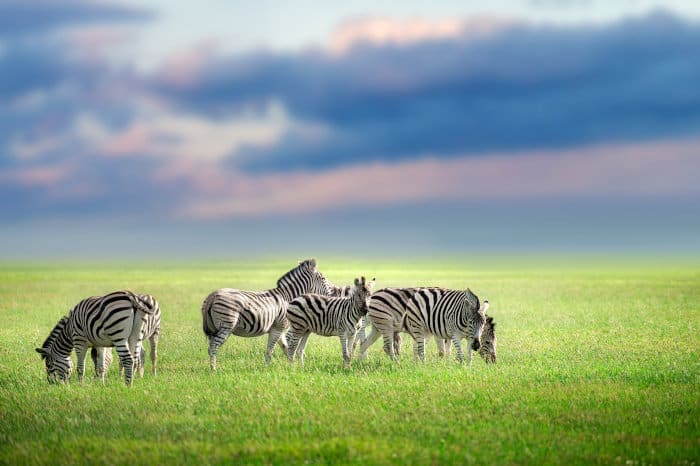
Both browsers and grazers play an important role in their ecosystems. The effects of their feeding methods impact many plant and animal species.
Some grazers have less specialised diets and can feed on lower-quality grasses. One example is the plains zebra, which is known as a “pioneer grazer”.
By munching on the longer, lower-nutrition plants, zebras help prepare the plains for species that eat shorter, nutritional grasses.
Browsing animals can slow the growth of trees and shrubs, preventing areas from becoming overgrown.
A high population of browsers, on the other hand, can lead to overbrowsing, and a lack of growth below a certain height.
The role of predators
Predators might not be popular with individual herbivores, but they’re necessary for a balanced ecosystem. By feeding on grazers and browsers, they can keep overgrazing and overbrowsing in check.
Even their presence deters herbivores from lingering too long in an area and depleting food resources.
Bigger herbivores = bigger impact

Large herbivores play an important role in seed dispersal, and there are none larger than the elephant.
Elephants eat vast amounts of food and travel long distances, depositing their nutrient-rich, seed-filled dung and affecting where plants grow.
So, despite their destructive feeding habits, they’re helping the next generation of plants.
Check Out Browsing vs Grazing Animals on Safari
If you venture out on safari, it probably won’t be long until you spot a range of herbivores. By now, you might even be able to notice some of the differences between browsers and grazers.
These herbivores are essential to their ecosystems and well-adapted to their own niches. Africa’s plant-eaters help shape the land itself, encouraging new growth and dispersing seeds.
Whether it’s witnessing an epic grazer migration across the plains, or spotting a scarce black rhino browsing among the bushes, planning a custom safari could help you see some of Africa’s amazing herbivores in action.
